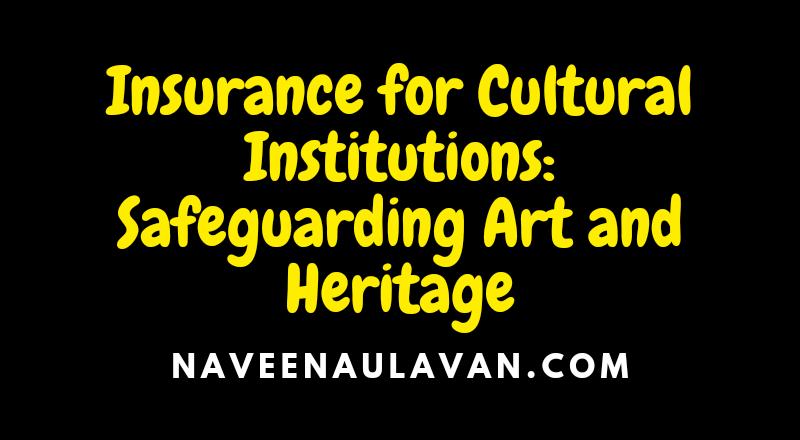Cultural institutions play a vital role in preserving and showcasing our art and heritage. From museums to galleries, libraries to historical landmarks, these institutions are responsible for safeguarding priceless artifacts and artworks. However, these invaluable treasures are not immune to risks such as theft, fire, and natural disasters. Insurance plays a crucial role in mitigating these risks and providing financial protection to cultural institutions. In this article, we will explore the importance of insurance for cultural institutions, the types of coverage available, and the challenges faced in ensuring adequate protection.
- The Importance of Insurance for Cultural Institutions
- Types of Coverage for Cultural Institutions
- Property Insurance
- Fine Art and Collections Insurance
- Business Interruption Insurance
- Liability Insurance
- Challenges in Insuring Cultural Institutions
- Valuation of Cultural Assets
- High Demand for Coverage
- Loss Prevention and Risk Management
- Documentation and Records Management
- Conclusion
The Importance of Insurance for Cultural Institutions
Cultural institutions are custodians of our history and cultural heritage. They house collections that are irreplaceable and often of significant cultural and historical value. As such, the loss or damage to these assets can be devastating. Insurance provides a safety net, ensuring that cultural institutions can recover financially in the event of a loss or damage. It allows these institutions to focus on their core mission of preserving and promoting art and heritage, knowing that they are protected against unforeseen events.
Types of Coverage for Cultural Institutions
1.
Property Insurance
Property insurance is the foundation of any insurance program for cultural institutions. It covers the physical assets of the institution, including buildings, collections, equipment, and furnishings. In the event of a fire, flood, or other covered perils, property insurance provides financial reimbursement for the loss or damage to these assets.
2.
Fine Art and Collections Insurance
This specialized form of insurance covers the specific risks associated with fine art and collections. It provides coverage for both owned and borrowed artworks, protecting against theft, damage during transportation, accidental breakage, and other perils. Fine art and collections insurance is especially important for cultural institutions that host temporary exhibitions or lend their artworks to other institutions.
3.
Business Interruption Insurance
Business interruption insurance is designed to protect cultural institutions from the financial impact of an unexpected closure. If a covered event, such as a fire or natural disaster, forces the institution to temporarily shut down, business interruption insurance can provide reimbursement for lost revenue, ongoing operating expenses, and additional expenses incurred during the closure. This coverage ensures that the institution can continue its operations and recover from the financial setbacks caused by the interruption.
4.
Liability Insurance
Liability insurance is essential for cultural institutions, as they often attract a large number of visitors. This coverage protects against claims of bodily injury or property damage that may occur on the premises. Liability insurance also extends to cover lawsuits related to intellectual property infringement or improper handling of artworks. It provides financial protection against costly legal expenses and settlements.
Challenges in Insuring Cultural Institutions
Insuring cultural institutions presents unique challenges due to the nature of the assets involved and the risks they face. Some of the key challenges include:
1.
Valuation of Cultural Assets
Valuing cultural assets, such as historical artifacts and rare artworks, can be complex and subjective. Insurance policies for cultural institutions often require precise and up-to-date appraisals to determine the appropriate coverage limits. The expertise of specialist appraisers and conservation professionals is crucial to accurately assess the value of these assets.
2.
High Demand for Coverage
Cultural institutions worldwide compete for insurance coverage, mainly in areas prone to natural disasters or with high crime rates. This high demand can lead to limited availability of coverage or increased premiums. Cultural institutions must work with insurance brokers experienced in the field to secure adequate and cost-effective coverage.
3.
Loss Prevention and Risk Management
Preventing losses and managing risks is crucial for cultural institutions. Insurance underwriters often require comprehensive risk management plans to be in place to minimize the likelihood and severity of potential losses. This may include implementing security measures, fire prevention systems, and disaster recovery plans. Cultural institutions must invest in these measures to enhance insurability and reduce premiums.
4.
Documentation and Records Management
Maintaining detailed documentation and records of the collections is essential for insurance purposes. Accurate inventories, condition reports, and provenance documentation assist in the claims process and ensure that proper coverage is available. Cultural institutions should implement robust systems for record-keeping and develop protocols for regular updates and reviews.
Conclusion
Insurance plays a crucial role in safeguarding the valuable assets of cultural institutions. From protecting against physical damage to providing financial support in the event of business interruption or liability claims, insurance allows these institutions to focus on their core mission of preserving and promoting art and heritage. While insuring cultural institutions presents unique challenges, working with specialized insurance brokers
